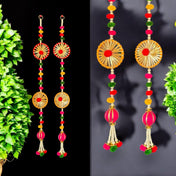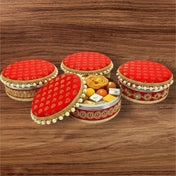Diwali, also known as the Festival of Lights, is one of India's most important and colorful festivals. It is celebrated not only in India but also by Indians living around the world. Diwali is a time for happiness, prosperity, and unity among communities.
What is Diwali? It is a festival that goes beyond religious boundaries, celebrated by Hindus, Sikhs, Jains, and Buddhists. Each community adds its own special customs and traditions to the celebrations, making the festival even more diverse and rich in culture.
By learning about the different ways Diwali is celebrated, we can better appreciate this wonderful festival. From lighting diyas (oil lamps) to stunning fireworks shows, every aspect represents the triumph of light over darkness and good over evil. This universal message connects with people from various cultures and backgrounds.
Join us as we explore the various ways Diwali is celebrated both in India and across the globe.
The Meaning and Significance of Diwali
Diwali, also known as Deepavali, comes from the Sanskrit words deepa (lamp) and avali (row), symbolizing a row of lamps. This vibrant festival is celebrated with immense joy and fervor, marking the victory of light over darkness.
Diverse Interpretations Across Religions
Diwali isn't just a Hindu celebration; it's embraced by various religions, each attributing unique significance to the festival:
- Hindus: Commemorate Lord Rama’s return to Ayodhya after defeating Ravana, celebrating the triumph of good over evil.
- Sikhs: Celebrate Bandi Chhor Divas, marking Guru Hargobind Ji’s release from imprisonment.
- Jains: Observe Diwali as the anniversary of Lord Mahavira's attainment of Nirvana.
- Buddhists: Particularly Newar Buddhists in Nepal, celebrate Diwali by worshipping Lakshmi, the goddess of wealth.
Central Themes
The essence of Diwali revolves around several core themes:
- Light Overcoming Darkness: Lighting diyas symbolizes dispelling ignorance and bringing knowledge into our lives. Handmade peacock tea light candle holders can enhance this experience, providing a beautiful way to light up homes.
- Triumph of Good Over Evil: Reflects moral values and righteousness, inspiring ethical conduct.
- Prosperity and Wealth: Worshipping Goddess Lakshmi to invite prosperity into homes and businesses. The Varalakshmi vratham gift hamper is a thoughtful way to honor this tradition.
"Diwali is more than a festival; it's a celebration of life’s virtues."
Embrace these themes and immerse yourself in the true spirit of Diwali. Incorporating traditional elements like the marigold garland hanging jhoomer into your decor can further enhance the festive ambiance. Additionally, gifting items such as pashmina shawls or decorative haldi kumkum holders can make for meaningful gestures during this auspicious time.
Historical Roots: From Ancient Legends to Modern Celebrations
Diwali's origins are deeply rooted in Indian culture, spanning back thousands of years. The festival is enriched by various legends and historical events that have shaped its significance over time.
Ancient Legends
The most popular story linked to Diwali is the return of Lord Rama to Ayodhya after a 14-year exile. According to the epic Ramayana, Lord Rama defeated the demon king Ravana, symbolizing the triumph of good over evil. The people of Ayodhya celebrated his return by lighting oil lamps, or diyas, illuminating the entire city.
Another significant legend is connected to Lord Krishna. In parts of India, Diwali commemorates Lord Krishna's victory over the demon Narakasura. This tale emphasizes the theme of light overcoming darkness, a central motif of the festival. To celebrate this aspect of Diwali, one might consider wearing a jewelry set for Janmashtami and Ganesh Chaturthi that reflects the rich cultural heritage associated with these deities.
Historical Influences
Historical events have also played a role in shaping Diwali. During the reign of Emperor Ashoka, Diwali evolved to include elements of peace and prosperity following his conversion to Buddhism. His emphasis on non-violence and harmony added layers of moral and ethical dimensions to the celebrations.
These ancient stories and historical influences collectively enrich Diwali, making it not just a religious festival but a celebration of cultural heritage and historical legacy. Understanding these roots provides a deeper appreciation for Diwali's diverse traditions and practices today.
In addition to its religious significance, Diwali also serves as an occasion for gifting and sharing. Eco-friendly Ganesha paper carry bags can be used for distributing sweets and gifts during the festival. Furthermore, traditional backdrops featuring Lord Krishna or scenes depicting his life such as Krishna with cow can enhance the festive decor during poojas or family gatherings.
Celebrating Diwali in India: Customs, Rituals, and Regional Diversity

Traditional Practices
Diwali traditions and customs are deeply rooted in Indian culture. One of the most significant practices is the Lakshmi Puja, where families pray to Goddess Lakshmi for wealth and prosperity. Homes are cleaned meticulously, decorated with rangolis, and adorned with oil lamps (diyas) to welcome the goddess. The use of wooden block print tea light candle holders has become a popular choice for decorating homes during this festive season.
Dhanteras: The Auspicious Day
Dhanteras marks the beginning of Diwali festivities. This day is considered highly auspicious for purchasing gold or silver items, symbolizing good fortune and prosperity. Many also buy new utensils and perform a small puja to honor Dhanvantari, the god of health and healing.
Regional Variations
India's diverse cultural landscape means Diwali celebrations vary widely across different states:
- Tamil Nadu: Celebrants take oil baths early in the morning as a purification ritual. Special sweets like Adhirasam are prepared.
- West Bengal: Known as Kali Puja, this region worships Goddess Kali during Diwali. Elaborate pandals (temporary structures) are set up for the deity.
- Maharashtra: The first day, known as Vasu Baras, involves honoring cows and calves. Families prepare traditional sweets like Anarse and Shankarpale.
- Punjab: Sikhs celebrate Bandi Chhor Divas, commemorating Guru Hargobind Ji's release from imprisonment. The Golden Temple in Amritsar is illuminated beautifully.
Prayer and Feasting
Across India, Diwali is a time for prayer and feasting. Families gather to perform rituals, exchange gifts, and enjoy sumptuous meals featuring various regional delicacies—gulab jamuns, laddus, kaju katli, and more.
Unique Customs
Each region adds its unique touch to Diwali:
- Oil Baths: Common in South India for purification.
- Firecrackers: Widely used across the country to signify joy and ward off evil spirits.
- Rangoli Designs: Artistic patterns made on floors using colored powders or flower petals.
Diwali's essence lies in its rich tapestry of customs that bring light into homes and hearts alike. As families come together to celebrate this festival of lights, it's also an opportunity to share love and joy through gifting. For those looking to spread happiness beyond Diwali, exploring unique collections such as Lohri gifts or even Christmas gift boxes can be a wonderful idea.
The Vibrant Festivities: Fireworks, Rangoli, and Sweets Galore!
Diwali is a festival that engages all our senses, with its lively celebrations that touch our hearts. The night sky is filled with breathtaking fireworks shows during Diwali, where each explosion of color reflects the happiness and thrill of the festival. Firecrackers, rockets, and sparklers light up the streets and rooftops, creating a stunning visual symphony that represents the main message of light conquering darkness.
Creating Beautiful Rangoli Designs at Home
Rangoli patterns are another essential part of Diwali celebrations. These intricate designs decorate doorways and courtyards, symbolizing hospitality and abundance. Making rangoli patterns at home is a beloved tradition that can be both creative and calming. If you want to elevate your rangoli-making experience, consider using a Diwali acrylic rangoli set which includes decorative pooja floor rangoli with studded stones.
Step-by-Step Guide to Making Rangoli:
- Choose Your Space: Select a clean, flat surface at your home entrance or in your courtyard.
- Design Outline: Use chalk or white powder to draw the basic outline of your rangoli design.
- Fill with Colors: Carefully fill the outlined spaces with colorful powders or flower petals.
- Add Details: Enhance your design with intricate details using finer materials like rice flour or sand.
- Light It Up: Place small diyas (oil lamps) around your rangoli to illuminate it beautifully during the evening.
These creative expressions not only beautify homes but also promote a sense of community as neighbors often come together to create larger designs.
The joy of Diwali continues with a wide variety of traditional sweets and treats prepared for this special occasion. From laddus to barfis and gulab jamuns, these goodies are generously shared among family, friends, and neighbors, further strengthening the bonds of togetherness during this joyous festival.
To enhance the festive atmosphere even more, unique candle holders can be used to brighten up the home. Consider exploring LoveNspire's collection for beautiful elephant candle holders that can significantly enhance your decor and create a cozy ambiance during the celebrations.
The Diaspora Experience: Keeping Tradition Alive Abroad
Members of the Indian diaspora celebrate Diwali with enthusiasm, combining traditional practices with local customs. This lively festival goes beyond borders, bringing together families and communities around the world.
Key Elements
- Prayer Rituals: Central to Diwali celebrations abroad, prayer rituals honor deities and seek blessings for prosperity.
- Festive Meals: Sharing elaborate meals that include traditional sweets like gulab jamun, jalebi, and savory dishes such as samosas and pakoras.
- Decorations: Homes are adorned with colorful rangolis, diyas, and fairy lights, creating a festive atmosphere reminiscent of India.
Local Adaptations
- Community Events: Organizing cultural programs featuring dance performances, music, and plays that reflect Indian heritage. Traditional attire becomes a significant part of these events. For instance, a mindhol rumal is often worn during such celebrations, adding to the cultural richness.
- Public Celebrations: Cities with significant Indian populations host public Diwali events, complete with fireworks displays and food stalls offering a taste of home.
Diwali abroad is a beautiful blend of age-old traditions and new influences, showcasing the adaptability and resilience of Indian culture. The celebration isn't just limited to food and prayers; it's also about wearing beautiful oxidized aesthetic earrings or traditional chandelier jhumkas, which add an extra sparkle to the festivities.
Global Celebrations: Uniting Cultures Through Joyful Festivities!
Diwali's cultural significance goes beyond borders, bringing together different communities in joyful celebration. Around the world, diaspora communities blend local customs and traditions with the spirit of Diwali.
United States
Cities like New York and San Francisco host grand Diwali festivals featuring Bollywood music, traditional Indian dance performances, and multicultural food stalls.
United Kingdom
London lights up with public events at Trafalgar Square, including rangoli art competitions and fusion cuisines blending British and Indian flavors.
Singapore
The Little India district dazzles with light displays and street markets. Traditional music blends seamlessly with contemporary beats, creating a vibrant atmosphere.
South Africa
Durban's Indian community celebrates with parades, showcasing a mix of African and Indian cultural elements, from Zulu dance to classical Bharatanatyam.
These adaptations reflect the unifying spirit of Diwali, celebrating light and joy while honoring local customs. Traditional attire plays a significant role in these festive celebrations. For instance, chand maang tikka jewelry is often worn by women during these festivities, adding an element of elegance to their outfits.
Moreover, the exchange of gifts is a common practice during Diwali. A pack of fabric potli bags can serve as perfect gift pouches for various occasions including nikah, mehendi or even housewarming parties. These bags not only hold gifts but also reflect the rich cultural heritage associated with Diwali celebrations.
Conclusion: Embracing Diversity in Unity During Festivals Like No Other!
Understanding What is Diwali, and how is it celebrated in India and the diaspora? reveals the essence of this festival. The victory over darkness during festivals like Diwali symbolizes the universal values we all cherish:
- Love for family bonds: Shared experiences during joyful occasions cement these connections.
- Unity in diversity: Celebrating different cultural practices enriches our understanding of one another.
Embrace the spirit of Diwali by appreciating these common values that bring us together. Light your diyas, enjoy the fireworks, and share sweets with loved ones. Celebrate unity through diversity.




















